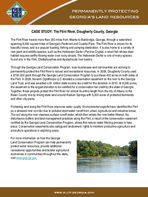CASE STUDY: The Flint River, Dougherty County, Georgia
The Flint River travels more than 350 miles from Atlanta to Bainbridge, Georgia, through a watershed spanning 8,460 square miles of Georgia's Piedmont and Coastal Plain. The Flint River is known for its beautiful views, and is a popular boating, fishing and camping destination. It is also home to a variety of rare plant and wildlife species, such as the Halloween Darter (Percina Crypta), a small fish whose ideal habitat requires swiftly-flowing water over rocky shoals. The Halloween Darter is one of many species found only in the Flint, Chattahoochee and Apalachicola river basins.
Through the Georgia Land Conservation Program, local businesses and communities are working to permanently protect the Flint River's natural and recreational resources. In 2008, Dougherty County used a $700,000 grant through the Georgia Land Conservation Program to purchase 400 acres on both sides of the Flint. In 2009, Nonami Oglethorpe LLC donated a conservation easement on the river to the Georgia Land Trust, and was awarded a $1 million state income tax credit for the donation in 2010. At 8,595 acres, the easement is the largest donation to be certified for a conservation tax credit by the state of Georgia. Together, these projects protect the Flint River for almost its entire length from the city of Albany to the Baker County line by linking state land around Radium Springs with 6,000 acres of protected farmlands and other city parks.
Protecting land along the Flint River improves water quality. Environmental experts have identified the Flint as a stressed river corridor due to polluted stormwater runoff from urban, agricultural and industrial areas. The soil along the river cleanses surface runoff water, which then enters the river better-filtered. Nodisturbance buffers and best management practices along the Flint, a result of the conservation easement certified by the Georgia Land Conservation Program, allows this natural water filtering process to take place. Conservation easements also safeguard landowners' rights to maintain productive agriculture and silviculture operations in adjoining areas.
For more information on how the Georgia Land Conservation Program can help permanently protect water resources, provide additional recreational opportunities and bolster agricultural economies in communities throughout the state, visit www.glcp.ga.gov.
